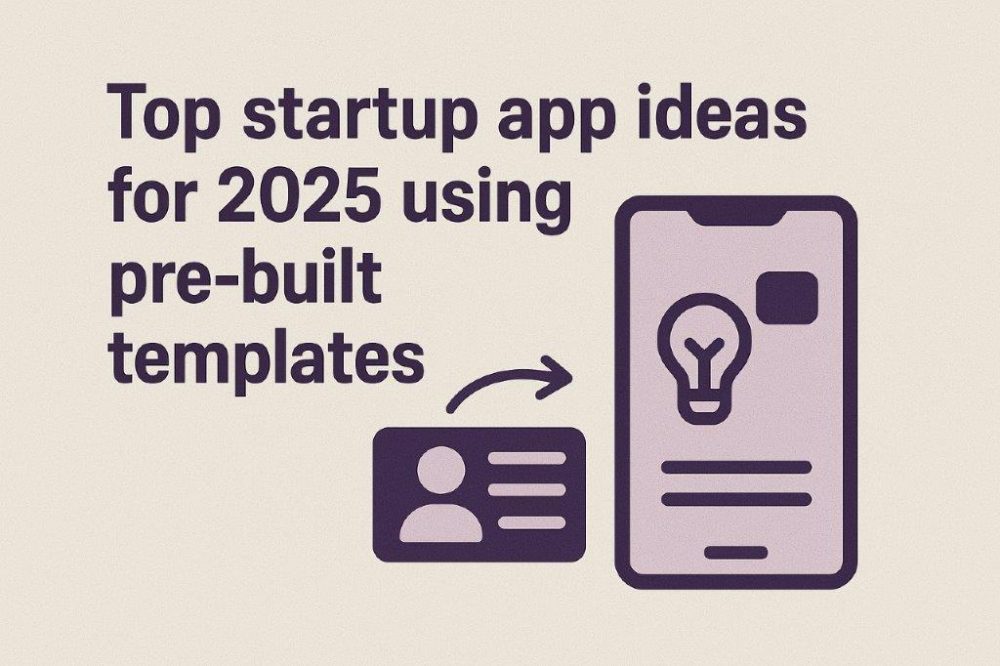The barrier to entry in the app market has never been lower, all because of the expansion of no-code and low-code platforms which use pre-built templates. For aspiring startup app in 2025, this technology is a complete game-changer, which enables Minimum Viable Products (MVPs) to be launched faster as well as cheaper than ever before. Using existing templates for key functionalities can help startups in focusing their resources on building specific customization, user experience, as well as market fit. The following app ideas are tactically positioned for success in 2025, allowing users to get the most out of existing tech templates while also solving modern, high-demand problems.
The Rise of Template-Driven Startups
The “no-code revolution” means that complex application types, like marketplaces, social networks, as well as CRM tools, are now easily available as foundational templates. These platforms are capable of offering the basic architecture, user authentication, database structure, as well as core workflows. This shift helps in empowering the citizen developer to quickly deploy apps in three key, high-growth categories:
Category 1: Hyper-Niche Marketplaces and Commerce
Sustainable Goods Exchange (Template: E-commerce/Marketplace):
Nowadays, consumers are becoming increasingly conscious about their carbon footprint. An app that is capable of focusing only on the local exchange, rent, or sale of a specific category of sustainable goods, like upcycled furniture, zero-waste cooking kits, or ethically sourced vintage apparel, fills a valued niche. The template is also capable of offering product listing, payment, along with user rating systems; the startup’s value lies in developing the niche as well as nurturing a hyper-local, high-trust community.
Hyperlocal Skill-Swap Platform (Template: Service Booking/Freelance):
Moving ahead of generic freelance sites, this app makes use of a booking template for facilitating localized, non-monetary skill exchanges. For example, think of a graphic designer exchanging work for a plumber’s service or a gardener teaching lessons in exchange for tech support. The template is capable of handling scheduling, profiles, as well as reviews, which in turn enables the startup to focus more on localized matching algorithms as well as trust-building features.
Category 2: AI-Enhanced Productivity and Personalization
AI-Driven Niche Content Supervisor (Content Publishing/Newsfeed):
Generic news aggregators are too broad, and the apps uses a content feed template by integrating a specialized AI to curate articles, podcasts, and videos for extremely narrow professional or hobbyist interests such as “Sustainable Urban Beekeeping” or “Web3 Legal Compliance”. The template handles the feed along with user profile; and the AI integration provides the hyper-personalized value.
Micro-Habit Stacker for Remote Teams (Task Management/Wellness Tracker):
The proliferation of remote and hybrid work continues, teams need more than just task lists. This app leverages a task/habit tracker template to create short, gamified, shared wellness habits for teams such as “3 minutes of stretching before meetings,” “no email response after 5 PM”. The template offers tracking and notifications; also, customization in the group/team-based accountability and playful challenges.
Category 3: Community and Wellness Tools
Niche Mental Health Companion (Template: Journaling/Chatbot):
A standard journaling as well as mood tracking template is capable of easily adjusting for serving a particular demographic like new parents, shift workers or even university students. Also, combining a simple AI chatbot for initial, non-clinical support can be a total game-changer. The template is capable of offering the secure logging as well as simple analytics; meanwhile the niche focus along with specialized content/chatbot training usually defines the app’s uniqueness as well as appeal.
Pet Health and Maintenance Manager (Template: CRM/Inventory Tracker):
This boring yet brilliant idea uses an inventory or CRM template for helping pet owners in tracking everything, from vaccination schedules, food inventory, medication refills, to even vet appointments across multiple pets. The template helps in offering the key structure as well as notification logic, which in turn helps in simplifying a common administrative headache for busy pet owners.
Conclusion
Landscape of startup in 2025 is characterized by swiftness as well as specificity. Entrepreneurs can avoid initial development work by commencing with strong, pre-built templates that ae available from no-code and low-code platforms. Success does not merely come from making a flawless, ground-up app rather it comes from recognizing problems of users in a high-demand sector (such as sustainability or niche wellness) and speedily modifying a template to offer a focused, outstanding solution. Moreover, app startups’ future is not dependent on coding brilliance, rather it is about template-driven agility as well as market focus which is as sharp as laser.
